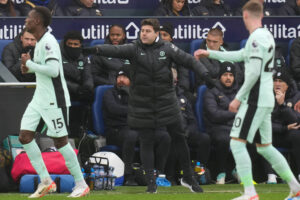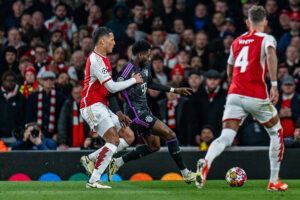Theo Walcott has already returned to Arsenal once this year, having played in Everton’s 5-1 thrashing by the Gunners in February, which came barely a fortnight after he had finally left The Emirates for Merseyside. Nevertheless, it will still be fascinating to see how he performs on Sunday when he will again line up against his old club. Can he finally show Arsenal that they lost something by selling him? Or will he again prove that he is football’s ultimate ‘lost boy’, who never translated his undoubted teenage potential into a serious, grown-up career?
Theo Walcott Returns to Arsenal With Everton
Constant Cameos
If ever there has been a career of cameos, it was Walcott’s at Arsenal. Signed from Southampton in January 2006 when he was still only 16, it was hoped that he would eventually become the replacement for Thierry Henry, who was already attracting the attention of Barcelona and would eventually sign for them in the summer of 2007.
However, what followed over the next decade was not the consistent brilliance of Henry but instead a succession of false starts, even false dawns, many of which still remain in the memory of frustrated Arsenal fans. The highlights include his first goal for the club in the League Cup Final of 2007, which Arsenal eventually lost to Chelsea 2-1; his stunning performance off the bench against Barcelona (and Henry) in 2010, when he somehow dragged the Gunners back from a 2-0 deficit to draw the first leg of their Champions League last-16 tie; and most memorable of all, his superb performance as the main (indeed lone) striker in the 2015 FA Cup Final, when he ran Aston Villa ragged and scored the first goal in what was eventually an easy 4-0 win.
Sadly for Walcott and for Arsenal, there was very little else besides those rare one-off displays. Wenger failed to do with Walcott what he had achieved so spectacularly with Henry, namely turning a fast winger (or at least wide player) into an outstanding striker. Perhaps it was always going to be a futile task, given the obvious physical differences between the tall, powerful Henry and the much smaller Walcott. However, the task certainly wasn’t made any easier by Henry’s eventual departure for Barcelona, given that Walcott had little more than a year to learn from the master exactly how to play up front on his own.
Not Quite the Right Fit
That last point may be the most salient when it comes to assessing Walcott’s career. Perhaps more than any other player in world football, he has suffered from the gradual move over the last two decades or so towards playing with only one out-and-out striker. Walcott is the modern equivalent of the ‘little man’ who, in the 1970s and 1980s, would have played alongside a ‘big’, or at least bigger, man in a striking partnership, like Gary Lineker or Gary Shaw, who played alongside taller target men like Alan Smith or Peter Withe. Perhaps Wenger had something along those lines in mind when he signed Walcott, given that he also signed the much taller and more physically powerful Emmanuel Adebayor at exactly the same time. However, it never worked out that way. Instead, Walcott was almost exclusively played on the wing, where he lacked both the trickery and the defensive discipline to thrive as a wide player in the modern game.
There was a brief period after that 2015 FA Cup Final performance against Aston Villa that it seemed Walcott might finally be given the chance to play up front on his own, as he had done in that final to great effect. However, the experiment did not last long. Perhaps most worryingly of all, Walcott himself seemed to experience the footballing equivalent of an existential crisis when he wondered, aloud and in public, whether he could ever play the striking role he had dreamed of. Eventually, he decided that he would be better off on the wing after all and with that decision, any realistic chance that he might have had of being a centre-forward was gone forever.
Not Alone
Of course, Walcott is not alone in having suffered a ‘lost decade’ at Arsenal under Wenger. Jack Wilshere is the other outstanding example of a young Gunner who never quite became the Arsenal legend he had initially appeared capable of becoming. Wilshere finally moved on this summer to West Ham, but he still seems beset by injury, with the latest unfortunate development being the revelation that he literally has a screw loose in his ankle. But there were several others, such as Alex Oxlade-Chamberlain and Callum Chambers, who never seemed to receive from Wenger the coaching they required to train on and become first-team regulars, let alone regular internationals.
Like Walcott and Wilshere, Wenger finally left Arsenal this year, but as Unai Emery is fast discovering, his legacy still lives on at the club. For all the magnificence of his achievements in his first decade at Arsenal, it is increasingly obvious that he took his eye off the ball in his second decade, when he seemed fixated on being a CEO as much as a manager. It is ironic, therefore, that the club’s actual CEO – Ivan Gazidis – finally confirmed this week that he will be leaving Arsenal for AC Milan, just when it appeared that he had, at last, won the control that he had always sought at the club.
As for Walcott, he will be 30 next year and it is extremely unlikely now that he will ever become the player that Wenger (or Sven-Goran Eriksson, who chose him for the 2006 World Cup before he had even played for Arsenal) thought he would develop into. As a result, Walcott would surely not be human if he did not occasionally regret, or even rue, the day he signed for Arsenal. Both he and Arsenal fans will forever wonder what might have been.
Main Photo






